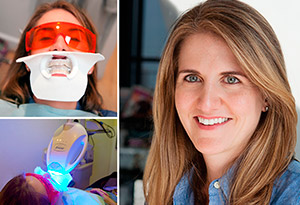Beauty Adventure: Finding a Teeth-Whitening Technology That Really Works
Our highly sensitive beauty editor tries the latest technology in teeth-whitening.

Photo: Kristine Wood
I've had a root canal, given birth to an almost-nine-pound, large-headed baby, and survived a bout of sepsis (not all at once, thank God). Also counted among the most painful experiences of my life: the first time I had my teeth professionally whitened. The year was 2006, and the procedure itself went smoothly (a dentist painted my teeth with peroxide, then shined a blue light on them for about 45 minutes). My smile was a gleaming white. But within a few hours, my newly bright teeth started aching. Then throbbing. It hurt to eat, drink, and talk. It hurt to breathe. The pain lasted 24 hours, and I vowed never to let peroxide touch my teeth again. I would simply offset their yellow tinge by wearing more beige.
Then, recently, Jeff Golub-Evans, DDS, suggested I give teeth-whitening another try. Because I look really peaked in beige—and time does indeed dull the memory of pain (I know people who've actually had a second child)—I found myself one morning wearing a paper bib in his office. Like many dentists, Golub-Evans now uses Philips's new Zoom WhiteSpeed lamp, which has three settings (low, medium, and high, instead of just high) and emits much less of the heat that exacerbates sensitivity. This Zoom system minimizes sensitivity with a more advanced bleaching gel as well, which releases peroxide gradually, not all at once. For the highly sensitive and only moderately stained (like me), Golub-Evans limits the procedure to one 20-minute session, rather than three back-to-back 15-minute ones. And immediately after the bleach is wiped from a patient's teeth, he applies a fluoride-based desensitizer to ensure that the peroxide won't continue to penetrate the enamel. I rose from his chair with, once again, a gleaming smile—and waited for the ache to set in. It's been two weeks, and I have yet to feel even a twinge.
$400 to $1000, ZoomWhitening.com
More on Makeovers:
Then, recently, Jeff Golub-Evans, DDS, suggested I give teeth-whitening another try. Because I look really peaked in beige—and time does indeed dull the memory of pain (I know people who've actually had a second child)—I found myself one morning wearing a paper bib in his office. Like many dentists, Golub-Evans now uses Philips's new Zoom WhiteSpeed lamp, which has three settings (low, medium, and high, instead of just high) and emits much less of the heat that exacerbates sensitivity. This Zoom system minimizes sensitivity with a more advanced bleaching gel as well, which releases peroxide gradually, not all at once. For the highly sensitive and only moderately stained (like me), Golub-Evans limits the procedure to one 20-minute session, rather than three back-to-back 15-minute ones. And immediately after the bleach is wiped from a patient's teeth, he applies a fluoride-based desensitizer to ensure that the peroxide won't continue to penetrate the enamel. I rose from his chair with, once again, a gleaming smile—and waited for the ache to set in. It's been two weeks, and I have yet to feel even a twinge.
$400 to $1000, ZoomWhitening.com
More on Makeovers:



